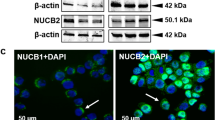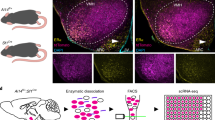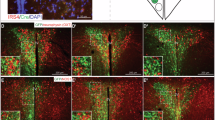Abstract
Objective:
Estrogen (E2) has an inhibitory effect on food intake by acting centrally in the hypothalamus, although it is not clear which hypothalamic neurons are involved in this process. Earlier studies from our lab and others have implicated neuropeptide Y (NPY) as an important central anorexigenic target of E2. This study was designed to investigate whether E2 can directly regulate NPY secretion and examine the cellular mechanisms and receptors responsible for this anorexigenic action of E2.
Design:
Clonal, murine, hypothalamic neuronal cell models, mHypoE-42 and mHypoA-2/12, were investigated for NPY secretory responses to 17β-estradiol (E2) in the presence or absence of pharmacological inhibitors directed against the phosphatidylinositol-3-kinase (PI3K), mitogen-activated protein kinase (MAPK) and AMP-activated kinase (AMPK) pathways or to estrogen receptor (ER) specific agonists/antagonists.
Measurements:
The presence of hypothalamic markers and characterization of neuronal cell lines was completed with polymerase chain reaction. NPY levels were measured using an enzyme immunoassay (EIA). The expression of ER-α and caveolin-1 was analyzed using immunocytochemistry.
Results:
E2 significantly decreased NPY secretion in both the mHypoE-42 and mHypoA-2/12 neurons. The E2-mediated repression of NPY secretion in the mHypoE-42 and mHypoA-2/12 neurons required ER-α, but not ER-β, as shown by studies using an ER-specific agonist/antagonists. Additionally, using immunocytochemistry we detected colocalization of ER-α and the membrane-associated signaling protein caveolin-1. Importantly, using E2-conjugated bovine serum albumin (E2-BSA) and ER antagonists, we were able to show that the E2-mediated decrease in NPY secretion occurred through membrane-bound ER-α. Finally, using a combination of pharmacological inhibitors, we found that inhibition of the PI3K or AMPK pathway blocked the E2-mediated decrease in NPY secretion.
Conclusion:
These findings indicate that the central anorexigenic action of E2 occurs at least partially through hypothalamic NPY-synthesizing neurons. This regulation of NPY secretion occurs through rapid signaling mechanisms through membrane bound ER-α.
This is a preview of subscription content, access via your institution
Access options
Subscribe to this journal
Receive 12 print issues and online access
$259.00 per year
only $21.58 per issue
Buy this article
- Purchase on Springer Link
- Instant access to full article PDF
Prices may be subject to local taxes which are calculated during checkout





Similar content being viewed by others
References
Pallier E, Aubert R, Lemonnier D . Effect of diet and ovariectomy on adipose tissue cellularity in mice. Reprod Nutr Dev 1980; 20: 631–636.
Tonkelaar ID, Seidell JC, van Noord PA, Baanders-van Halewijn EA, Jacobus JH, Bruning PF . Factors influencing waist/hip ratio in randomly selected pre- and post-menopausal women in the dom-project (preliminary results). Int J Obes 1989; 13: 817–824.
Mohamed MK, Abdel-Rahman AA . Effect of long-term ovariectomy and estrogen replacement on the expression of estrogen receptor gene in female rats. Eur J Endocrinol 2000; 142: 307–314.
Gambacciani M, Ciaponi M, Cappagli B, Piaggesi L, De Simone L, Orlandi R et al. Body weight, body fat distribution, and hormonal replacement therapy in early postmenopausal women. J Clin Endocrinol Metab 1997; 82: 414–417.
Haarbo J, Marslew U, Gotfredsen A, Christiansen C . Postmenopausal hormone replacement therapy prevents central distribution of body fat after menopause. Metabolism 1991; 40: 1323–1326.
Pedersen SB, Borglum JD, Moller-Pedersen T, Richelsen B . Effects of in vivo estrogen treatment on adipose tissue metabolism and nuclear estrogen receptor binding in isolated rat adipocytes. Mol Cell Endocrinol 1992; 85: 13–19.
Toth MJ, Poehlman ET, Matthews DE, Tchernof A, MacCoss MJ . Effects of estradiol and progesterone on body composition, protein synthesis, and lipoprotein lipase in rats. Am J Physiol Endocrinol Metab 2001; 280: E496–E501.
Santollo J, Eckel LA . Estradiol decreases the orexigenic effect of neuropeptide Y, but not agouti-related protein, in ovariectomized rats. Behav Brain Res 2008; 191: 173–177.
Bonavera JJ, Dube MG, Kalra PS, Kalra SP . Anorectic effects of estrogen may be mediated by decreased neuropeptide-Y release in the hypothalamic paraventricular nucleus. Endocrinology 1994; 134: 2367–2370.
Pelletier G, Li S, Luu-The V, Labrie F . Oestrogenic regulation of pro-opiomelanocortin, neuropeptide Y and corticotrophin-releasing hormone mRNAs in mouse hypothalamus. J Neuroendocrinol 2007; 19: 426–431.
Broberger C, Johansen J, Johansson C, Schalling M, Hokfelt T . The neuropeptide Y/agouti gene-related protein (AGRP) brain circuitry in normal, anorectic, and monosodium glutamate-treated mice. Proc Natl Acad Sci USA 1998; 95: 15043–15048.
Stanley BG, Kyrkouli S, Lampert S, Leibowitz S . Neuropeptide Y chronically injected into the hypothalamus: a powerful neurochemical inducer of hyperphagia and obesity. Peptides 1986; 7: 1189–1192.
Wahlestedt C, Heilig M . Neuropeptide Y and related peptides. In: Bloom F (ed). Psychopharmacology-The Fourth Generation of Progress, on-line edition. Lippincott Williams & Wilkins: Philadelphia, PA, 1994, http://www.acnp.org/g4/GN401000052/CH401000052.html.
Clark JT, Kalra PS, Crowley WR, Kalra SP . Neuropeptide Y and human pancreatic polypeptide stimulate feeding behavior in rats. Endocrinology 1984; 115: 427–429.
Sahu A, Kalra SP, Crowley WR, Kalra PS . Evidence that NPY-containing neurons in the brainstem project into selected hypothalamic nuclei: implication in feeding behavior. Brain Res 1988; 9: 376–378.
Shimizu H, Ohtani K, Kato Y, Tanaka Y, Mori M . Withdrawal of [corrected] estrogen increases hypothalamic neuropeptide Y (NPY) mRNA expression in ovariectomized obese rat. Neurosci Lett 1996; 204: 81–84.
Belsham DD, Cai F, Cui H, Smukler SR, Salapatek AM, Shkreta L . Generation of a phenotypic array of hypothalamic neuronal cell models to study complex neuroendocrine disorders. Endocrinology 2004; 145: 393–400.
Belsham DD, Fick LJ, Dalvi PS, Centeno ML, Chalmers JA, Lee PK . et al. Ciliary neurotrophic factor recruitment of glucagon-like peptide-1 mediates neurogenesis, allowing immortalization of adult murine hypothalamic neurons. Faseb J 2009; 23: 4256–4265.
Titolo D, Cai F, Belsham DD . Coordinate regulation of neuropeptide Y and agouti-related peptide gene expression by estrogen depends on the ratio of estrogen receptor (ER) alpha to ERbeta in clonal hypothalamic neurons. Mol Endocrinol 2006; 20: 2080–2092.
Gingerich S, Krukoff TL . Estrogen modulates endothelial and neuronal nitric oxide synthase expression via an estrogen receptor beta-dependent mechanism in hypothalamic slice cultures. Endocrinology 2005; 146: 2933–2941.
Gingerich S, Krukoff TL . Estrogen in the paraventricular nucleus attenuates L-glutamate-induced increases in mean arterial pressure through estrogen receptor beta and NO. Hypertension 2006; 48: 1130–1136.
Nilsson S, Makela S, Treuter E, Tujague M, Thomsen J, Andersson G et al. Mechanisms of estrogen action. Physiol Rev 2001; 81: 1535–1565.
Titolo D, Mayer CM, Dhillon SS, Cai F, Belsham DD . Estrogen facilitates both phosphatidylinositol 3-kinase/Akt and ERK1/2 mitogen-activated protein kinase membrane signaling required for long-term neuropeptide Y transcriptional regulation in clonal, immortalized neurons. J Neurosci 2008; 28: 6473–6482.
Shughrue PJ, Lane MV, Merchenthaler I . Comparative distribution of estrogen receptor-alpha and -beta mRNA in the rat central nervous system. J Comp Neurol 1997; 388: 507–525.
Osterlund M, Kuiper GG, Gustafsson JA, Hurd YL . Differential distribution and regulation of estrogen receptor-alpha and -beta mRNA within the female rat brain. Brain Res Mol Brain Res 1998; 54: 175–180.
Filardo EJ, Quinn JA, Frackelton Jr AR, Bland KI . Estrogen action via the G protein-coupled receptor, GPR30: stimulation of adenylyl cyclase and cAMP-mediated attenuation of the epidermal growth factor receptor-to-MAPK signaling axis. Mol Endocrinol 2002; 16: 70–84.
Razandi M, Pedram A, Greene GL, Levin ER . Cell membrane and nuclear estrogen receptors (ERs) originate from a single transcript: studies of ERalpha and ERbeta expressed in Chinese hamster ovary cells. Mol Endocrinol 1999; 13: 307–319.
Pappas TC, Gametchu B, Watson CS . Membrane estrogen receptors identified by multiple antibody labeling and impeded-ligand binding. Faseb J 1995; 9: 404–410.
Andersson U, Filipsson K, Abbott CR, Woods A, Smith K, Bloom SR et al. AMP-activated protein kinase plays a role in the control of food intake. J Biol Chem 2004; 279: 12005–12008.
Han SM, Namkoong C, Jang PG, Park IS, Hong SW, Katakami H et al. Hypothalamic AMP-activated protein kinase mediates counter-regulatory responses to hypoglycaemia in rats. Diabetologia 2005; 48: 2170–2178.
Kalra SP, Dube MG, Pu S, Xu B, Horvath TL, Kalra PS . Interacting appetite-regulating pathways in the hypothalamic regulation of body weight. Endocr Rev 1999; 20: 68–100.
Dagnault A, Richard D . Involvement of the medial preoptic area in the anorectic action of estrogens. Am J Physiol 1997; 272: R311–R317.
Butera PC, Czaja JA . Intracranial estradiol in ovariectomized guinea pigs: effects on ingestive behaviors and body weight. Brain Res 1984; 322: 41–48.
Acknowledgements
Support: This work was supported by the Canadian Institutes for Health Research (CIHR) Operating Grants. D.D.B. holds a Canada Research Chair in Neuroendocrinology.
Author information
Authors and Affiliations
Corresponding author
Ethics declarations
Competing interests
The authors declare no conflict of interest.
Rights and permissions
About this article
Cite this article
Dhillon, S., Belsham, D. Estrogen inhibits NPY secretion through membrane-associated estrogen receptor (ER)-α in clonal, immortalized hypothalamic neurons. Int J Obes 35, 198–207 (2011). https://doi.org/10.1038/ijo.2010.124
Received:
Revised:
Accepted:
Published:
Issue Date:
DOI: https://doi.org/10.1038/ijo.2010.124
Keywords
This article is cited by
-
Pharmacological inhibition of neuropeptide Y receptors Y1 and Y5 reduces hypoxic breast cancer migration, proliferation, and signaling
BMC Cancer (2023)
-
Neuroendocrine microRNAs linked to energy homeostasis: future therapeutic potential
Pharmacological Reports (2022)
-
The detection of specific hypermethylated WIF1 and NPY genes in circulating DNA by crystal digital PCR™ is a powerful new tool for colorectal cancer diagnosis and screening
BMC Cancer (2021)
-
Stomach secretes estrogen in response to the blood triglyceride levels
Communications Biology (2021)
-
Protective Effects of Notoginsenoside R1 via Regulation of the PI3K-Akt-mTOR/JNK Pathway in Neonatal Cerebral Hypoxic–Ischemic Brain Injury
Neurochemical Research (2018)



